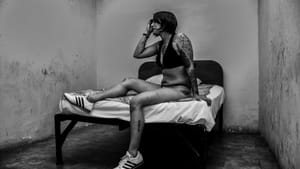Stay in the Loop
BSR publishes on a weekly schedule, with an email newsletter every Wednesday and Thursday morning. There’s no paywall, and subscribing is always free.
Dark travels in Mexico's skin trade
Twenty-Two Gallery presents Ada Trillo's 'How Did I Get Here?'

Twenty-Two Gallery’s new black-and-white photography exhibition, How Did I Get Here?, from Juarez, Mexico-born (now Philadelphia-based) artist Ada Luisa Trillo, depicts drug-addicted Mexican prostitutes laid bare, in every sense of the word. They exist in what the artist says is the “intersection of sympathy, dignity, and hope.” Through Trillo’s eyes and lens, each woman — no matter how dire her circumstance, no matter if she has died or lives on, doing what she must to survive — is given an elegance of line, a richness of silver halide, and an air of regal comportment.
From Mary Ellen Mark’s “Lata nude, laughing with her customer in her bed” to Nan Goldin’s "Nan one month after being battered" to Zoe Strauss’s “Daddy Tattoo,” adventurous women photographers have covered their sisters in crisis — in the desperate straits of forced prostitution, physical abuse, and drug addiction — for as long as the camera has been a tool for documenting sad, stark truths.
For her first-ever project as a photographer (her mien is abstract painting, a medium she did not feel would capture the spirit, pain, and tearful terror of these new subjects), Trillo watched the women of Juarez. Caught in the crosshairs of the area’s violent drug cartels, area women are often abducted by the gangs and put to work as prostitutes, drug mules, or both.
Fear and defiance
You can sense as much fear in Trillo’s tremulous, tactile work as you do its stateliness, looking at the naked, sculptural bodies. Some are skeletally thin, such as “Alexis"; some are fleshy and stretched, like “Coco.” Most have taut, tanned faces hardened by dehumanizing work, soul-sucking poverty, the woozy grip of drugs, or all three.
Of that fear, Trillo said at the exhibition's opening, “I could have been one of them. You don’t choose where you were born, which is why I wanted people to see what a life without opportunities looks like. People know it exists, but they just don’t want to see it. I want to present this, show it to their face, because this needs to be addressed. These women are a neglected part of society, and because of judgment they are marginalized not only in Mexico but throughout the world.”
Trillo had to pay each woman for her 15 minutes of sitting time. (“That is all they are allowed from their pimps,” she explained, to keep the production line moving). She acted nearly alone in documenting the detritus surrounding women smoking crack, a postcoital moment, or her subjects simply laughing and smiling defiantly. The most triumphant of these snaps are the two featuring “Dionisia.”
The gallery viewer can sense the urgency Trillo must have faced in capturing subjects such as majestic “Coco” (who survived to become a matriarch of sorts, doling out condoms and lubricants) in repose. Trillo had to contend with the idea that she was documenting the majority of these battle-worn, dragged-down women before they disappeared; indeed, most of the women suffered violent deaths soon after their photo sessions.
With but one harsh and rousing exhibition, Ada Trillo has made herself into the Nan Goldin of the 21st century.
What, When, Where
How Did I Get Here? By Ada Luisa Trillo. All artist sales proceeds benefit the Coalition against Trafficking in Women. Through August 6, 2017, at the Twenty-Two Gallery, 236 S. 22nd Street, Philadelphia. (215) 772-1911 or twenty-twogallery.com.
Trillo moderates a panel July 19, 2017, with Dr. Laura Bamford of Philadelphia FIGHT, street photographer Ronald Corbin, and Juarez social worker Blanca Cercada.
Sign up for our newsletter
All of the week's new articles, all in one place. Sign up for the free weekly BSR newsletters, and don't miss a conversation.

 A.D. Amorosi
A.D. Amorosi